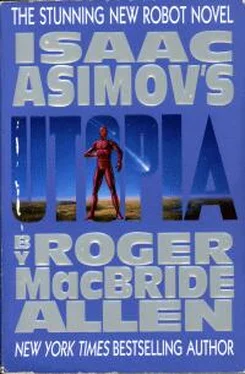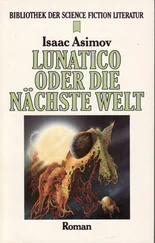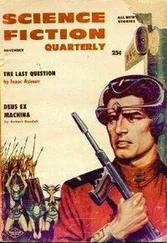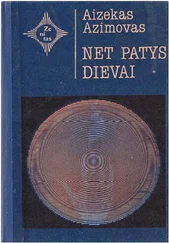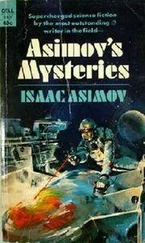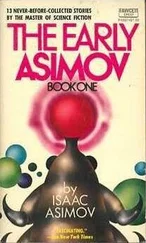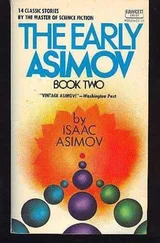Isaac Asimov - Utopia
Здесь есть возможность читать онлайн «Isaac Asimov - Utopia» весь текст электронной книги совершенно бесплатно (целиком полную версию без сокращений). В некоторых случаях можно слушать аудио, скачать через торрент в формате fb2 и присутствует краткое содержание. Год выпуска: 1996, ISBN: 1996, Издательство: Ace Trade, Жанр: Фантастика и фэнтези, на английском языке. Описание произведения, (предисловие) а так же отзывы посетителей доступны на портале библиотеки ЛибКат.
- Название:Utopia
- Автор:
- Издательство:Ace Trade
- Жанр:
- Год:1996
- ISBN:ISBN: 044-100245-5
- Рейтинг книги:5 / 5. Голосов: 1
-
Избранное:Добавить в избранное
- Отзывы:
-
Ваша оценка:
- 100
- 1
- 2
- 3
- 4
- 5
Utopia: краткое содержание, описание и аннотация
Предлагаем к чтению аннотацию, описание, краткое содержание или предисловие (зависит от того, что написал сам автор книги «Utopia»). Если вы не нашли необходимую информацию о книге — напишите в комментариях, мы постараемся отыскать её.
Utopia — читать онлайн бесплатно полную книгу (весь текст) целиком
Ниже представлен текст книги, разбитый по страницам. Система сохранения места последней прочитанной страницы, позволяет с удобством читать онлайн бесплатно книгу «Utopia», без необходимости каждый раз заново искать на чём Вы остановились. Поставьте закладку, и сможете в любой момент перейти на страницу, на которой закончили чтение.
Интервал:
Закладка:
He looked out the porthole of the Settler spaceship, looked out into space, out at the realest thing he had ever seen in his life. There it was, just ten kilometers away. Comet Grieg, an ice mountain cruising through the darkness of space.
It was no abstraction inside a computer, no simulated image in a holographic generator. It was real. It was there. And it was huge, far larger than he had imagined it being, far larger than mere numbers could have told him. It took up half the sky, and seem to take up more. It was a dark, brooding shape of dirty gray, half lost in shadow. A monster out of the darkness, and, thanks to him, it was aimed straight at Inferno.
It was, roughly speaking, an oblong spheroid, but that made the shape of it sound simple and abstract. It was a real world, if a small one, with a geography complicated enough to have kept a generation of mapmakers busy. Its surface was so pocked with craterlets and covered in crags arid gullies and cracks that it was hard to study anyone feature on the surface before it got lost among all the others.
Comet Grieg was one of a special class of so-called “dark” comets. Inferno’s star system had plenty of normal comets, of the classic “dirty snowball” type composed primarily of water ice and other volatiles. But for reasons that still were not entirely understood, star systems with poorly developed planetary systems also seemed to produce a large number of dark comets—and Inferno shared its star with only two planets barely large enough to qualify as gas giants, a wizened little asteroid belt, and the usual sorts of deep space debris-comets, asteroids, planetesimals, and so on.
Called “dark” because they produced relatively small tails, and were composed of darker material, dark comets were closer to being asteroids encased in ice than anything else. Grieg had a particularly large proportion of stony material, but it contained plenty of water ice and other volatiles. A hazy nimbus of gas and dust and ice shards floated about the behemoth, bits of debris from the size of molecules up to the size of small aircars that had either been knocked loose by the natural heating and outgassing as the comet neared the sun, or else thrown clear by human interference.
A searchlight from a closer-in ship stabbed through the cloud of debris and struck the surface of Comet Grieg, flooding one small area on the surface with a light so bright, so clear, it did not seem to belong on such a darkened surface. A smooth and perfect cylindrical shape stuck up out of the comet’s surface. Davlo recognized it. It was one of the dozens of thrusters planted on the comet’s surface. He had helped calculate their placement, and played at least a small part in working out the firing sequence that had been used to eliminate the comet’s spin. It had been in a wobbling two-axis tumble when the task force had arrived. Now the spin had been restored and refined, and the comet’s nose was pointed straight at the sun.
But the sun would have no further chance to melt this comet. Davlo looked from Comet Grieg to the sunshade, a huge and insubstantial parasol floating in space a kilometer or so sunward of the comet, forming a permanent solar eclipse as seen from the surface of Grieg.
Left to its own devices, Grieg would have melted and boiled and sublimed away a substantial amount of material by now, forming a coma that would, in turn, have been blown back by the solar wind into a modest tail. But the sunshade stopped all that, and kept the comet in the deep freeze.
The parasol was itself being blown back by the solar wind, slowly drifting in toward the comet. In about another day or so it would come into contact with the comet, moving far too slowly for it to be called a crash. The parasol would drape itself around the comet like a small handkerchief dropped onto a large egg. It would tear in places, and the work crews would cut deliberate holes in it where it served their purposes, but that would be of no consequence. The parasol would reflect sunlight just as handily, losing only a few percentage points of its effectiveness.
Davlo Lentrall could not help but wonder what Kaelor would have thought of all this. He would have had some sardonic comment to make, no doubt, some dour turn of phrase that would capture the weaknesses in the plan in fewer words than anyone else. Or, Davlo wondered, was he making Kaelor too human? Kaelor had died in a futile attempt to prevent the comet capture. It stretched credulity to the breaking point to imagine he could be witness to the event, first hand, without the Three Laws taking hold of him, forcing him to desperate action. Davlo Lentrall was finding it more and more easy to understand desperation, and how it might drive someone to do something dangerous.
But one did not have to think on the grand scale to see this was no place for robots. Davlo looked out the port again, and spotted two tiny, space-suited figures moving some huge and unidentifiable piece of machinery about on the surface of the comet. A misplaced step, a crack in a faceplate, a shove to the machine that was a trifle too hard, and one or both of them would be dead. It was impossible to imagine any modem robot allowing humans to do anything so risky.
Davlo glanced at the wall chronometer, and realized that his break was nearly over. More out of duty than desire, he began to eat, the motion mechanical, the taste of the food unnoticed. Back to work. He would have help with the final check-calculations for the placement of the main detonation thrusters. It should have been humbling, galling even, for Dr. Davlo Lentrall, the man who had seen the potential of Comet Grieg, the man who had dreamed the dream and planned the plan, to be assigned a position as minor as assistant calculation engineer. Glory and accolades should have been his.
But, somehow, he no longer saw it that way. Others here, mostly the Settlers, were far more skilled at handling the detailed mathematics of moving a small world through space. He saw his position as a penance, and a fitting one. How brilliant and noble could his vision have been if his closest associate was willing to die in order to stop it? Davlo found himself embarrassed and ashamed whenever someone recognized him and congratulated him on his grand plan. Most of the crew had learned to avoid the subject, and, indeed, had learned to avoid Davlo.
But he had been sent here to do work, and he had agreed to do it. So he accepted the tasks he was given, and did them as best he could. Besides, work got his mind off things. He could worry about solving the equation, determining the proper thrust and orientation. Off-shift was the worst, nights spent staring into the darkness, thinking of all the ways things could go wrong. No, he wanted no congratulations.
Something inside him had changed. Or was it merely that something had been burned out, destroyed, when he watched Kaelor destroy himself! Surely the last of the old Davlo had died with Kaelor? Had anything, anyone, taken the old Davlo’s place, or was he just an empty shell of a man, going through the motions?
No. Never mind. Think about other things. Think about the plan to move the comet.
Davlo’s initial plan had been to use a fairly standard high-yield nuclear bomb, but the Settler-designed detonation thrusters were a vast improvement on that idea. In essence, a d-thruster was a nuclear bomb set off inside a powerful force field formed in the shape of a huge rocket nozzle. The force field directed the force of the explosion into the proper direction, in effect producing a shaped charge that was far more efficient and far more controllable.
Other explosive charges were being rigged as well, of course. Once the comet had been redirected into its intercept course with Inferno, it would still be quite some distance away from the planet. It would take it just over thirty-two days to move from the point in space where the initial course change was made to its intercept with Inferno.
Читать дальшеИнтервал:
Закладка:
Похожие книги на «Utopia»
Представляем Вашему вниманию похожие книги на «Utopia» списком для выбора. Мы отобрали схожую по названию и смыслу литературу в надежде предоставить читателям больше вариантов отыскать новые, интересные, ещё непрочитанные произведения.
Обсуждение, отзывы о книге «Utopia» и просто собственные мнения читателей. Оставьте ваши комментарии, напишите, что Вы думаете о произведении, его смысле или главных героях. Укажите что конкретно понравилось, а что нет, и почему Вы так считаете.
